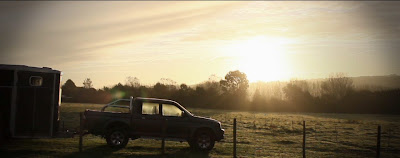You can use Andrew Goodwin’s (dancing in the distraction factory, 1992) critical framework to analyse our new music video for ‘Up in Flames’ – Coldplay (Mylo Xyloto). From viewing our video you can see that it conforms to the typical conventions of a modern music video in that there is a clear relationship between the music and visuals as well as an increasingly popular convention of visuals before the music begins.
The music video conforms to conventions of this genre of alternative pop, for example we shot at 720p at 50 frames per second allowing us to slow the footage 50%, giving the video a dull emotional feel. We further reinforced this through emotional colouration and de-saturating our image around 40%-this gave a cold, seriousness to the video. Also the iconography in the video, specifically costumes the character wear are modern and commonly associated with the ‘pop’ scene.
The performance in the video is conventional in some respects however in others it could be seen as quite an artistic, conceptual approach. For example the protagonist is lip syncing to the lyrics although this action is very normal he seems to be in an unconventional location of a rural area, which challenged stock locations. Therefore some shots of flames and the teddy burning are very unconventional of this style as the performance shots seem incongruous and disjunctive.
The post production is somewhat conventional in that the typeface is related to the traditionally used ‘Every true type is a waterfall’ font in the Mylo Xyloto album. They are used for the main titles in the video whilst the record label logo is also shown to be conventional. A slightly transparent effect by changing the opacity of the title is shown which creates a unique style. Using these fonts also increases the bands meta-narrative and image as they are used with the Mylo Xyloto album. This construction is also reflective of the genre.
The video employs an artistic/creative approach to conventions in that there are many shots throughout the video that seem irrelevant to any kind of narrative such as the flames and light bulbs. They may also seem unconventional in that much like the child lip syncing; the bulbs and brick seem unorthodox in relation to the music creating it as a pastiche and reworking of a deeper meaning or signifier. Although these shots seem disjunctive they are a part of a narrative, this creates repeatability and an intriguing style.
Goodwin discussed the relationship between lyrics and visuals to be an important convention. In relation to the whole video, it is clear that the main singer is lip-syncing in time as well as moving to the beat expressively. This reinforces the words and themes trying to be portrayed. However in the chorus sequence it is more performance-based and lip-syncing is shown more loosely as visuals are primarily based upon ‘flames’ and destruction. This is because the image of the real flames is a much more powerful image that the shot of purely one singer as it is more illustrative, especially for the chorus where the song is more upbeat creating an amplified message. This is important on a song of slower pace.
He also considered the relationship between music and visuals to be important conventions. In certain shots we can see evidence of some kind of link between the music and narrative trying to be portrayed. There is a hard narrative to understand and could also be seen as a pastiche of certain elements such as a child’s life or a situation is metaphorically going ‘up in flames’. In some negotiated readings we are unsure on the particular meaning of this narrative and therefore quite a lot of enigma surrounds the narrative.
He also considered the relationship between music and visuals to be important conventions. In certain shots we can see evidence of some kind of link between the music and narrative trying to be portrayed. There is a hard narrative to understand and could also be seen as a pastiche of certain elements such as a child’s life or a situation is metaphorically going ‘up in flames’. In some negotiated readings we are unsure on the particular meaning of this narrative and therefore quite a lot of enigma surrounds the narrative.
The narrative also draws upon binary oppositions through the juxtaposition of the solitary child and happy children in the background. This is done through their raw emotions as the protagonist is seen to be dull and emotionless whilst the children are laughing and enjoying themselves. Also through iconography and mise én scene the dull and dark costume of the protagonist contrasts against the children’s warm, bright, colourful clothing. The bands meta narrative is addressed through the symbols on the protagonists cheek. These relate to the album and Coldplay overall image.
He made reference to the notion of looking. The particular effect represented in this music video is how the boy is and the only character in the video breaking the fourth wall and looking directly into the camera, reaching out to the viewing and allowing us to see into their emotions through an extra diegetic gaze.











No comments:
Post a Comment